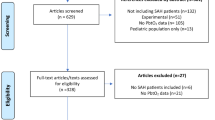Abstract
Objective
To determine the role of hyperoxic and hyperbaric therapy following experimental subarachnoid hemorrhage (SAH).
Design
Prospective, randomized, controlled animal study.
Subjects
Thirty male Wistar rats.
Interventions
Thirty rats were assessed for an initial neurologic status as double-blinded by two different neurosurgeons using a neurologic severity score (NSS) and then underwent an initial angiographic examination. Two days later, 0.3 ml of homologous blood was injected into the cisterna magna to produce a SAH-induced cerebral vasospasm. The NSS and angiographic examination were then repeated. The rats having no spasm or a spasm under 50% (n=8) and 50% or over 50% (n=22) were grouped separately, as groups 1 and 2, respectively. The rats having 50% or more spasm were further divided randomly into group 2A and 2B. The rats in groups 1 and 2A (n=11) underwent a 60-min course of 100% oxygen at the atmospheric pressure 1 atmosphere absolute (ata), and group 2B (n=11) received 100% oxygen at 3 ata for 1 h. Neurologic assessment was repeated on the next day and 7 days later.
Measurements and main results
The animals having no spasm or less than 50% spasm had a better NSS and outcome when compared with the animals having 50% or more spasm. But the animals with 50% or more spasm which underwent hyperbaric therapy were shown to have a better outcome compared to the animals having hyperoxic therapy.
Conclusion
Exposure to hyperbaric oxygen therapy seemed to accelerate the recovery of neurologic deficits secondary to experimental SAH.



Similar content being viewed by others
References
Hieshima GB, Higashida RT, Wapenski J (1986) Balloon embolization of a large distal basilar artery aneurysm: case report. J Neurosurg 65:413–416
Zubkov YN, Nikiforov BM, Shustin VA (1984) Balloon catheter technique for dilatation of constricted cerebral after aneurysmal subarachnoid hemorrhage. Acta Neurochir 70:65–79
Iwatsuki N, Takahashi M, Ono K, Tajima T (1994) Hyperbaric oxygen combined with nicardipine administration accelerates neurologic recovery after cerebral ischemia in a canine model. Crit Care Med 22(5):858–863
Kapp JP (1979) Hyperbaric oxygen as an adjunct to acute revascularization of the brain. Surg Neurol 12:457–461
Krakovsky M, Rogatsky G, Zarchin N, Mayevsky A (1998) Effect of hyperbaric oxygen therapy on survival after global cerebral ischemia in rats. Surg Neurol 49:412–416
Takahashi M, Iwatsuki N, Ono K, Tajima T, Akama M, Koga Y (1992) Hyperbaric oxygen ischemia therapy accelerates neurologic recovery after 15 minute complete global cerebral ischemia in dogs. Crit Care Med 20:1588–1594
Dong H, Xiong L, Zhu Z, Chen S, Hou L, Sakabe T (2002) Preconditioning with hyperbaric oxygen and hyperoxia induces tolerance against spinal cord ischemia in rabbits. Anesthesiology 96:907–912
Kohshi K, Yokata A, Konda N, Munaka M, Yasukouchi H (1993) Hyperbaric oxygen therapy adjunctive to mild hypertensive hypervolemia for symptomatic vasospasm. Neurol Med Chir 33:92–99
Kawamura S, Ohta H, Yasui N, Nemoto M, Hinuma Y, Suzuki E (1988) Effects of hyperbaric oxygenation in patients with subarachnoid hemorrhage. J Hyperbar Med 3:243–256
Feldman Z, Gurevitch B, Artru AA, Oppenheim A, Shohami E, Reichental E, Shapira Y (1996) Effect of magnesium given 1 hour after head trauma on brain edema and neurological outcome. J Neurosurg 85:131–137
Delgado TJ, Brismar J, Svendgaard NA (1985) Subarachnoid hemorrhage in the rat: angiography and fluorescence microscopy of the major cerebral arteries. Stroke 16:595–601
Gabrielsen TO, Greitz T (1970) Normal size of the internal carotid, middle and anterior cerebral arteries. Acta Radiol (Diagn) 10:1-10
Veltkamp R, Warner DS, Domoki F, Brinkhous AD, Toole JF, Busija DW (2000) Hyperbaric oxygen decreases infarct size and behavioural deficit after transient focal cerebral ischemia in rats. Brain Res 853:68–73
Fujita T, Kitani Y (1978) Intracellular electrolytes in erythrocytes during and after shock: relation to impaired consciousness. J Trauma 18:345–354
Theilen H, Schrock H, Kuschinsky W (1994) Gross persistence of capillary plasma perfusion after middle cerebral artery occlusion in the rat brain. J Cereb Blood Flow Metab 14:1055–1061
Hossmann KA (1996) Peri-infarct depolarizations. Cerebrovasc Brain Metab Rev 8:195–208
Ahrens M, Wiegand F, Liao W, Megow D, Dirnagl U (1998) Cerebral free radicals generated by hyperbaric oxygen induce tolerance against permanent focal ischemia in the rat. Neurosci Abstract 87:2
Thom SR (1993) Functional inhibition of leucocyte B2 integrins by hyperbaric oxygen in carbon monoxide—mediated brain injury in rats. Toxicol Appl Pharmacol 123:248–256
Thom SR, Mendiguren I, Hardy K, Bolotin T, Fisher D, Nebolon M, Kilpatrick L (1997) Inhibition of human neutrophil B2-integrin-dependent adherence by hyperbaric O2. Am J Physiol 272:770–777
Mink RB, Dutka AJ (1995) Hyperbaric oxygen after global cerebral ischemia in rabbits reduces brain vascular permeability and blood flow. Stroke 26:2307–2312
Safor P (1986) Cerebral resuscitation after cardiac arrest: a review. Circulation 74:138–153
Rolfsen CL, Dawis W (1989) Cerebral function and preservation during cardiac arrest. Crit Care Med 17:283–292
Lambertsen CJ, Kough RH, Cooper DY (1953) Oxygen toxicity. Effects in man of oxygen inhalation at 1 and 3.5 atmospheres upon blood gas transport, cerebral circulation and cerebral metabolism. J Appl Physiol 5:471–486
Yasu T (1986) H2O2 generation in rat brain in vivo correlates with oxygen pressure. Masui 35:1077–1082
Germano AF, Dixon CE, d'Avella D, Hayes RL, Tomasello F (1994) Behavioural deficits following experimental subarachnoid hemorrhage in the rat. J Neurotrauma 11 (3):345–353
Zwiebel WJ (1995) Cerebrovascular Doppler applications. In: Taylor KJW (ed) Clinical applications of Doppler ultrasound.) Raven Press, New York, pp 109–131
Author information
Authors and Affiliations
Corresponding author
Rights and permissions
About this article
Cite this article
Kocaoğullar, Y., Üstün, M.E., Avci, E. et al. The role of hyperbaric oxygen in the management of subarachnoid hemorrhage. Intensive Care Med 30, 141–146 (2004). https://doi.org/10.1007/s00134-003-1916-7
Received:
Accepted:
Published:
Issue Date:
DOI: https://doi.org/10.1007/s00134-003-1916-7




